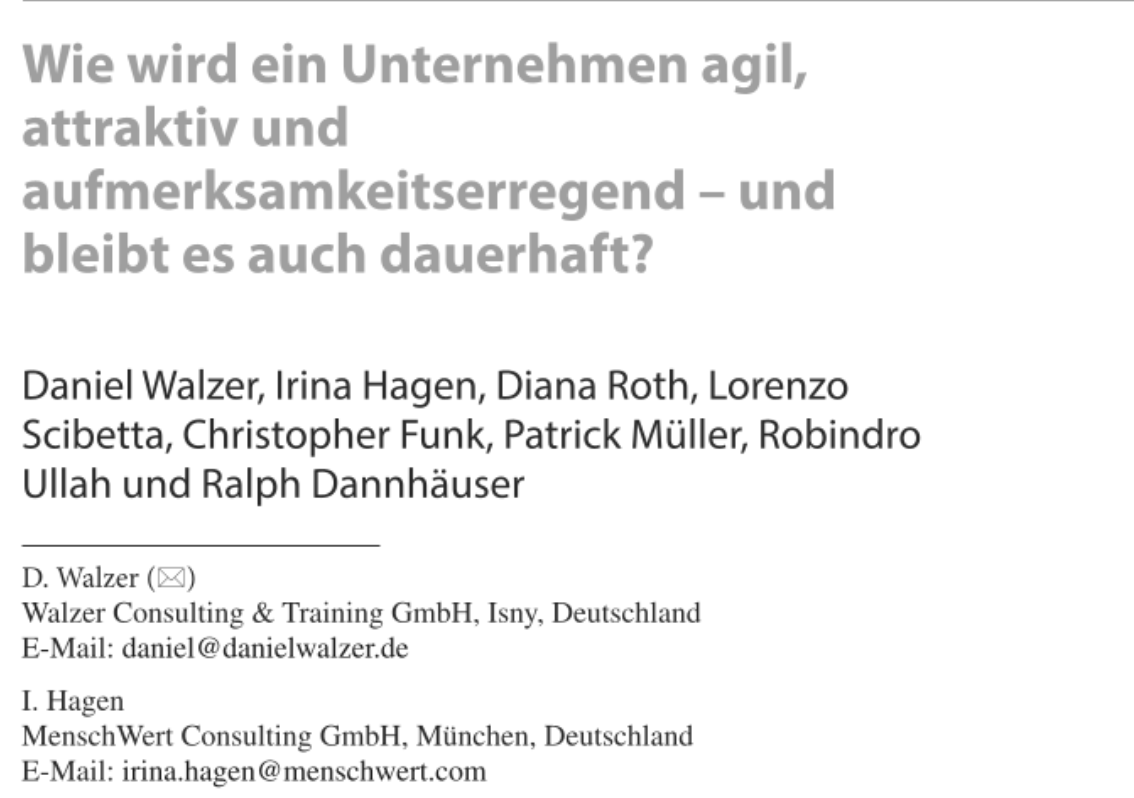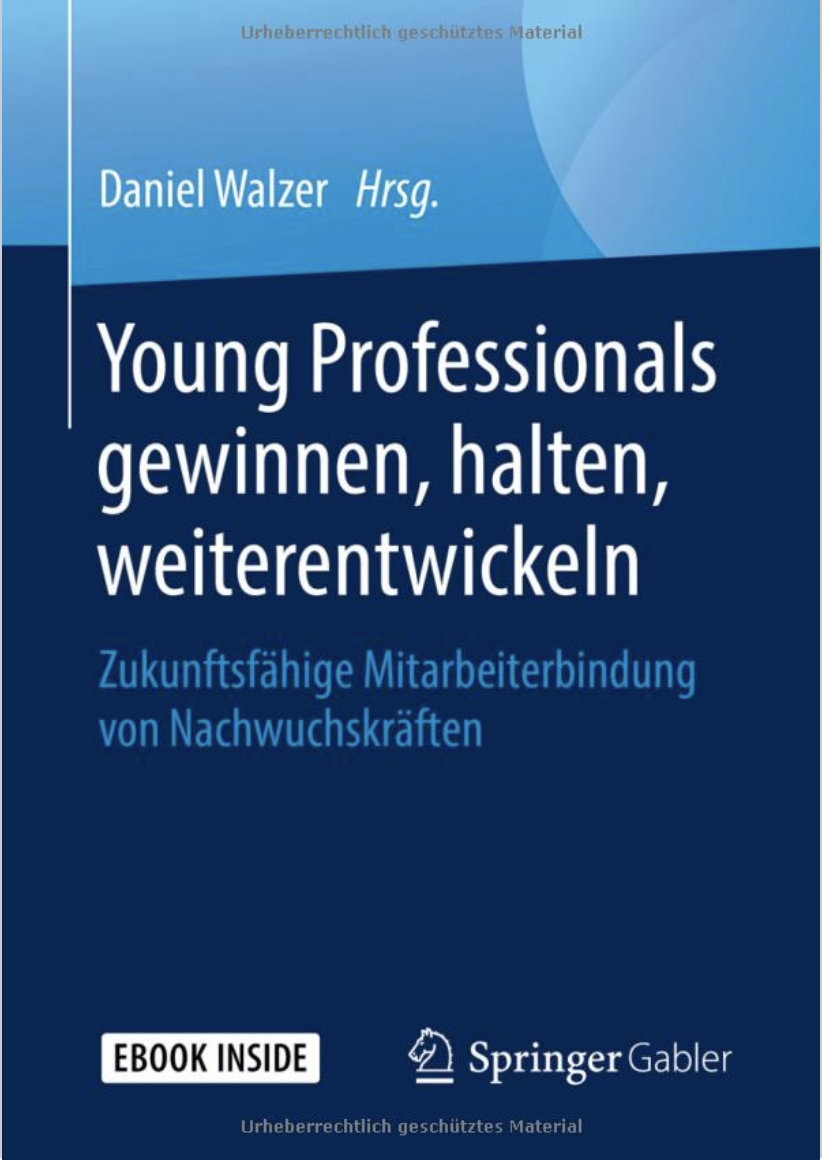
Why interim management boosts SMEs
In our rapidly changing business world, companies are constantly facing new challenges. This is exactly where interim management shows its true value – not only in large corporations. You still hear the preconception that interim management is merely a luxury tool for multinational companies, but this perspective is outdated. Far from the clichés about gentlemen with mottled gray temples in expensive suits and high daily rates, today a multi-faceted industry presents itself: experts from a wide range of specialist areas, equipped with comprehensive expertise, a broad horizon of experience and a sense for effective solutions. Especially in medium-sized businesses, where the potential of interim management often seems to be unrecognized, it can become a key tool. I invite you to explore the versatility of interim management, put aside biases and discover why it may be an invaluable tool.
Interim management goes far beyond simply bridging vacancies

Whether as a stopgap until the final staff member is on board, as a replacement on parental leave, as project manager, or as a “right-hand partner” to enrich resources or temporarily needed technical expertise – their reasons for deployment are manifold. Often, external managers take on tasks that involve a certain political sensitivity, where impartiality, clarity and diplomacy are required. Competent IMs combine new perspectives with strong implementation skills to ensure, together with the existing staff, that “things just work out”. And success? You can see it in clear operational indicators.
Both roles have their own validity and importance. Consultants bring the valuable outside perspective and deliver strategies and recommendations based on their analyses, without having direct responsibility for implementation. Interim managers, on the other hand, take on specific roles at the heart of the organization and thus contribute directly to value creation. Often with leadership responsibility, they are responsible for the realization of strategies and tangible results. With additional expertise in change management, interim managers can accelerate transformations in the shortest possible time because they do not merely implement measures at one point, but integrate them permanently into everyday life together with the people.
That is why I am delighted to take on interim mandates across the entire spectrum of HR management, be it in talent management, recruiting or employer branding. As an IM, I support teams and executives in their day-to-day business, remove stumbling blocks, act as a role model and lend a hand where needed. I work directly with the specialist groups and experts in the company and check which strategies are really successful. Not all consulting ideas are always practice-ready, however, with this insider perspective, I gain deep insights that refine my consulting approaches, make them feasible, and tailor them precisely to the needs of the business. Each mandate sharpens my understanding of the pitfalls of day-to-day operations and expands my range of solutions.

Vorteile des Interim-Managements
Everyday competence & problem solving
IMs act like open-heart surgeons: They react promptly and precisely to problems without getting lost in sprawling PowerPoint presentations. It is often the supposedly small inconsistencies in a company that lead to challenges in their entirety. Problems deeply rooted in the operational DNA require direct intervention at the employee level. With their ability to make decisions directly on the store floor, interim managers achieve sustainable improvements. In constant exchange with management, they solve everyday hurdles – whether in spontaneous hallway conversations, through precise interventions in meetings, or through the immediate adjustment of priorities.
Empowerment of the team
In der Beratung spricht man oft darüber was wie warum zu tun ist. Aber der Teufel steckt im Detail der Umsetzung. Fähige Interim Manager:innen sehen sich als Entwickler und Mentoren. Durch den Aufbau vertrauensvoller Beziehungen und geschickte Teammoderation schaffen sie es, Menschen das Rüstzeug und das Selbstvertrauen zu geben, Herausforderungen selbstständig zu meistern – anstatt die Dinge nur besser zu wissen. Das wahre Kunststück im Interim Management ist es, das Team nicht nur anzuleiten, sondern es zu inspirieren und zu befähigen. Dabei steht der gemeinsame Spaß an der Entwicklung und das Erfolgserlebnis im Vordergrund, wenn wirkungsvolle, nachhaltige Lösungen Hand in Hand erarbeitet werden.

The value of a sparring partner
Interim managers combine a fresh perspective with insider knowledge and thus become irreplaceable allies for clients. Their objective distance makes it possible to critically question entrenched world views, while at the same time they know the operational framework and limits. Unburdened by internal power struggles and politics, they speak the unvarnished truth and at the same time, thanks to their diplomatic skills, create a safe space for overcoming challenges – both of a professional and personal nature.
Choosing the right interim manager
Finding the right interim manager is an art that goes beyond the mere analysis of qualifications. It is essential not only to look at an impressive list of past projects, but to recognize the actual competence and fit for the specific challenge of the company. In this respect, networks and specialized agencies are more than simple intermediaries: they provide support in looking behind the scenes and identifying a candidate’s potential for the specific task, especially when things have to move quickly. In addition, they accompany the success of the mandate and, if necessary, provide advice as an insider third party. It’s a balancing act between experience, cultural fit and the ability to deliver real results in the given situation.
Folgende Kriterien zeichnen fähige Interim Manager:innen aus:
Fachliche Expertise und Methodenkompetenz
Interim managers are characterized by comprehensive expertise, which includes both technical tools and broad methodological competence. While specialized expertise stands for depth of content and attention to detail, methodological competence enables the correct application of this knowledge in different contexts. IMs skillfully maneuver between operational usefulness and the strategic needs of the business. In this way, they not only act as professional role models, but also ensure that corporate goals are in line with day-to-day operations and are implemented efficiently.
Understanding of strategy and business goals
A sound understanding of corporate strategy and objectives is essential to create holistic solutions. An interim manager must think beyond the specialist area and see the projects in the context of the entire company and the market. This is the only way to avoid the danger of isolated solutions that work in the short term but are not sustainable in the long term and could harm the company as a whole. The point is not just to optimize individual processes, but to always keep an eye on the big picture, and not to act according to the motto “operation successful, patient dead”.
Emotional competence
Rapidly building resilient relationships is critical to gaining trust with employees and stakeholders. It is essential to recognize and value the emotional needs of all stakeholders. Especially in tense situations, the ability to overcome contradictions and to approach conflicts in a solution-focused manner is crucial. An empathetic, yet clear and decisive approach is the key to successful trust work.
Synergies through systematic collaboration
In our complex world, success stands or falls with the quality of collaboration. It is not just about acting as a team, but above all about actively, consciously and effectively shaping overarching collaboration. This requires special competencies and the knowledge of methods to work without additional complexity or delays. Only when collaboration is not only demanded, but also skillfully encouraged, do real synergies and clout emerge.
Communication and facilitation skills
It is not enough to be right! In order to achieve real impact, the ability to both convey content in a comprehensible and graspable way and to moderate between different interest groups is crucial. The art of presenting complex issues concisely, bringing together different perspectives and facilitating effective collaboration is indispensable. Here, the talent to build bridges and reconcile the dialog is just as important as the methodical knowledge to lead exchanges of opinions in a goal-oriented way.
Promote decision-making dynamics
To be successful in an interim project, it is not enough to wait for decisions to be made, but understand how to actively initiate and drive the decision-making process. This means bringing together the right stakeholders, creating clarity and accelerating the achievement of consensus-based solutions without compromising on the quality of the decision. It is crucial that these decisions are sustainable and not questioned later.
Flexibility and compatibility
Just like an experienced sailor who adjusts his sails depending on the wind direction and strength, an IM must also react flexibly to the given framework conditions. What’s more: Just like two grandiose technical devices that provide no common benefit without a compatible interface, procedures and solution approaches must be ‘connectable’. They must fit harmoniously into the existing corporate structure. This means always having a deep understanding of the given structures and culture of the company in order to develop effective and integrated solutions.
Being humble and critical
As an interim manager, you act as a point of contact on key issues. To be humble is essential to appreciate the efforts and achievements of the team so far and to be aware that you are a learner in a new context first. There will always be critique. While a thick skin helps, a certain permeability is also required to accept criticism, to learn from it.
Personal responsibility & confidence
In muddled situations, when much has already been tried, the challenge is to identify the minimum room for maneuver. A deep sense of intrinsic ownership and the charisma of confidence are essential to credibly convey that more is always feasible than it seems at first glance and to energetically turn opportunities into results.
Success factors for effective and enjoyable collaboration
The harmonious cooperation and joint success in the collaboration with an interim manager are based on some essential cornerstones. First and foremost is close and trusting communication with the client. Through lively exchanges, both sides can share expectations, set common milestones and enjoy progress. Equally central is a clear understanding of the given conditions, so that everyone knows what they can build on. This includes defined resources, jointly defined goals and a clear timeframe. And last but not least, the interim manager should be granted reliable room for maneuver within which he:she can operate. With these three pillars – open communication, transparent framework conditions and defined room for maneuver – the cooperation can flourish and lead to mutual success.
Interim Management offers more than just a solution for personnel bottlenecks.
The seemingly high daily rates have usually paid for themselves within the first few weeks. In a world of constant change, the integration of interim management can represent a significant competitive advantage. As an interim manager, I bring my heart and mind to the table. An open exchange is important to me. That is why I am always happy to receive feedback in order to achieve the best results together.
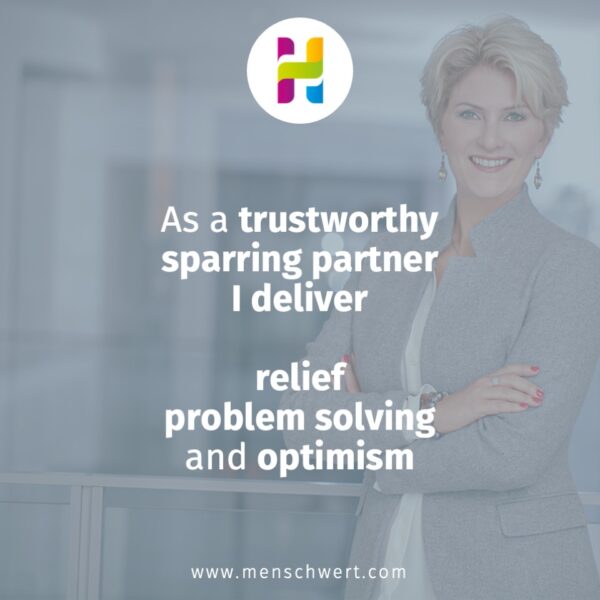

The Men in Grey in business world: Why a focus on efficiency and optimization gets in the way of transformation
In Michael Ende’s novel “Momo”, the men in grey are a metaphor for the loss of ease and joy of life, which are essential for progress and development. Due to an exaggerated emphasis on efficiency and process optimization, we recognize similar phenomena in our modern business world: instead of creating real added value, we experience more and more tasks, overflowing calendars, overtime, and general exhaustion – in other words: high rotation in idle – despite a focus on optimizing “operational excellence”.
It seems that the time thieves actually exist. “No time” is the most common response, when asked why the real issues are not being addressed with the seriousness they deserve. At first, just like in the novel, the men in grey sound “reasonable” and bring amazing economic results in the short term. No sooner do you have your time savings than they are forgotten and an inexplicable chill remains. The gray gentlemen in the narrative are symbolic of the pitfalls of a one-sided focus on efficiency and optimization because they often neglect human relationships, creativity, and further development.
Lean management and CIP (continuous improvement processes) have dominated business life in recent decades. The spirit of the times shows us that this phase is coming to an end. We feel that “business as usual” will not help us anymore. Although continuous improvement of the existing is and remains enormously crucial for competitiveness, it should not be in the foreground because it gets in the way of true renewal. Instead of asking how the existing can be made better, it is much more a matter of reflecting on whether what you are doing is the right thing at all or whether a completely new approach is needed.
A guide that is very personal to me

People are not machines, and our organizations are complex systems in which individual competence, independent thinking, participation, synergies and co-creation are the central elements. Applied correctly, technology, automation and digitization facilitate collaboration.
It takes a paradigm shift to be truly successful and not just caught in the grind of higher-faster-further. I would like to encourage us to learn from the lessons of Momo to bring about a profound change in the world of work and bring back to the forefront the importance of real results, further development and co-creation. I think it’s time to rethink our focus on efficiency and process optimization and instead embrace the changes we need to make. This is the only way to free ourselves from the shackles of time thieves in business and create a sustainably successful future.
I think you just have to listen to him, even when he's not singing.
For half a year the canary does not make a sound. Momo sits down with him and he starts to sing.
How often does it happen that we only listen to those who are loud. How often are the people who don’t use their voices the ones who matter?

No time for human togetherness
Lean management and continuous improvement process (CIP) are management concepts that aim to minimize waste and inefficiency. In the novel, the time of simply being together is considered waste. But is it still responsible today to use this way of looking at things as the sole management mindset?
In my everyday life, the desire for uncomplicated, explicit and streamlined processes with clear responsibilities (the RACI matrix sends its regards) is still very strong, although an overly stringent division of labor is alienating us more and more. In the complexity of today’s working world, it is no longer possible to define everything. Instead of strengthening ownership and a sense of responsibility, this way of thinking tends to lead us to withdraw into the process and our own realm, preferring to be cautious before tackling things ourselves.
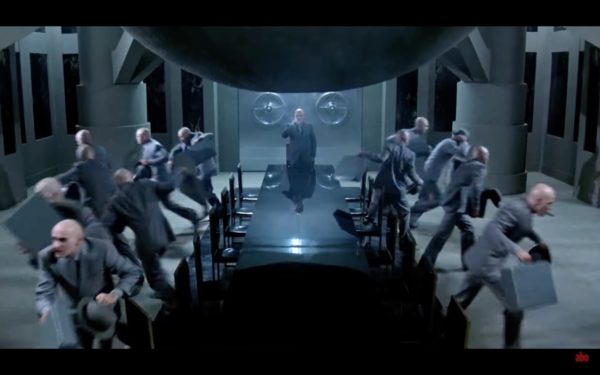
The inappropriate focus on processes

People love to solve problems. In “Operational Excellence” it is often suggested that there are no more problems that require some tinkering. That problems are bad, and you just have to put in some effort to overcome “challenges”. This usually leaves you alone with your problem until you just accept it and don’t care anymore. To courageously tackle the big issues, you need a sense of belonging and self-efficacy.
In the story, the men in grey create a culture where people focus on their own isolated success. Momo’s friends experience a focus on solving their own agenda, their own tasks. There is simply no time for the problems of others.
Sense of belonging as an essential success factor
In most companies, there is a strong process orientation, a focus on one’s own defined area of responsibility, instead of a focus on collaboration. People concentrate on their own tasks and the exchange is limited (if at all) to the mutual exchange of information or, in the best case, interface coordination. For many, the private conversation during lunch break is the only relevant interpersonal encounter. If the optimized process has priority, and not the common task of generating real added value, there is little room for human relationships. If the sequence of tasks is too structured, there is no longer any reason to talk to each other and alienation is the result.
However, nothing strengthens a sense of belonging like solving collective problems. Trust is built by addressing different perspectives, and overcoming conflict. This requires a deep understanding of the issues, shared goals, personal reflection, and deep listening.
No time for reflection
Momo encourages us to create opportunities where new perspectives are playfully explored. Let’s ask ourselves: Are we not only doing what we do right (efficiency), but doing the right thing? The answer requires space for reflection and critical questioning of our processes and decisions. It’s not just about the how, but also the “what” and “why.” Does what we are doing still fit with the overall goals? What guidelines do changing conditions give us? Which values do we want to promote? Do we have the appropriate resources and competencies for the tasks ahead of us?
Agility provides us with many tools. Retrospectives are an essential part of all agile frameworks. Retrospectives do not question the result and the product quality, but the way of working together, which patterns of thinking and acting need to be changed and which challenges arise on the way. And yet, the first thing that gets cut is consideration or no time is given to work through the findings.
Momo loves to ask questions and give space to the answers. Asking the right questions is an art and learning this can take time. Answers to difficult questions take time and possibly multiple iterations. This is what the men in grey hate. Momo gains too much power from this, because Momo’s friends love this game of philosophical perspectives to find solutions for their own lives.
No time for togetherness
Only by working together can we master the complexity of the world, create real results and prevent duplication of effort and actionism. When each and every employee recognizes his or her own importance for the company, the roles are lived accordingly. Each role has its own unique competence that is learned and developed. If people feel how their own self-efficacy contributes an important part to the result, they contribute creatively in the sense of the community and take responsibility as a matter of course.
For Momo, every single character is important. Through Momo’s belief in the person, the characters grow beyond themselves. They develop their strengths and independent thinking. Unfortunately, to the chagrin of the gray masters, this makes them less susceptible to the measures and manipulation of the time thieves.
If there is no time to explore one’s role and associated competencies, essential aspects of the role are overlooked. It is easier to list tasks than to delve into the deeper meaning of the role. And how often does time press in onboarding, after all, to get into the prefabricated processes as quickly as possible and to work through the assignments provided there unchecked. The workflows that result from insufficient understanding of the role sooner or later paralyze the entire organization.
No genuine involvement
It’s time to combine both ease and focus and create spaces where the team can playfully explore new perspectives without fear of failure or the pressure to always be efficient.
Repeatedly, I have witnessed how play in the work context has become empty entertainment, amusement without depth. It’s no wonder that employees sometimes feel they’ve been taken for fools. Nothing against climbing gardens, spaghetti towers and bowling evenings. It can be a lot of fun, I just doubt the effect. If a tight agenda and a focus on results are added to this, the purpose is reduced to absurdity. Too often, games and so-called icebreakers serve more of a superficial, detached alibi than enabling emotional connection or exploration. A plaster on the flesh wound. And the impression of being misunderstood, mentally isolated, and associated inner withdrawal with “good face to bad game” intensifies.
The gray masters try to stop creativity and intuition in precisely the same way. They entertain the children, confuse equality with equalization and provide toys en masse. Their toys are empty of content, create no real connection but the hunger for “more”. Amusement without joy and fulfillment, without the feeling of having really accomplished something together, without the pride of having dived through shallows and overcome obstacles together, are symptoms of misunderstood entertainment games, in an otherwise process-optimized rigid world.
The children and adults in Momo’s Amphitheater, on the other hand, are highly focused and confront difficulties. They consciously choose adventures that are thoroughly challenging; no destination is too far. They are willing to make an effort, to stand up for each other, and to immerse themselves fully in the subject matter. They genuinely connect with each other, resolve conflicts and unite perspectives. It is natural for them to involve everyone, accept individual characters as they are, recognize strengths, and commit to the common cause. Their game works without a moderator or motivator, without an entertainer or idea generator. In the atmosphere of Momo’s world, people feel encouraged, children and adults alike, to approach the world in a playful way and discover possibilities associated with it.
Restoring seriousness and weight to play means creating a culture where everyone can and will contribute their ideas and actively participate. A culture in which independent and autonomous individual thinking is encouraged and demanded in order to build thoughts together. Giving employees confidence and room to play is key to realizing the full potential of our organizations. Through playful experimentation, we can find new ways and develop bold ideas in line with the Think Big motto that go beyond conventional thought patterns.
What is Momo's secret?
Momo’s secret is her ability to listen to people and give their time. She helps people to better appreciate their own time and life (i.e. their resources) and to use them wisely and consciously for the benefit of the community.
She takes people as they are, without judgment. She is curious about who these people are and feels deep joy when others develop and are happy. She is at peace with herself and her being. Neither does she try to be someone she is not, nor is she ashamed of who she is.
The gift of deep listening enables her to help others solve their problems and find fulfillment. Through her profound understanding of the meaning of time and her extraordinary empathy, Momo is able to fight the gray masters and save those around her.

More relevant than ever
The story of Momo and the men in grey is more relevant today than ever. In a business world increasingly dominated by efficiency and optimization, we need to focus on the aspects that really drive us forward: Collaboration and togetherness, people at the center, individual competence and independent thinking, participation and the co-creation of value. By breaking away from rigid management mindsets and making room for the new, we can inspire, shake up and encourage to achieve all that is possible when we focus on what matters.
It’s time we muster the courage to say goodbye to the gray masters and their sole focus on efficiency and process optimization. Let’s set bold goals together, generate real added value, create spaces for human relationships and creative freedom, and together shape a better future for all.
By creating spaces for new perspectives and bringing human relationships back to the forefront, we can realize the full potential of our organizations and shape a better future for all.
Let’s be inspired by Momo. With lightness, depth and true joy.
Disclaimer: My love for Lean

I accompany many “Lean Transformations” and am convinced of the approaches of Lean Management. There are many areas where the validity is undisputed. Depending on the maturity level and current challenges, Lean principles can be very important.
My main point here was to show that in general there is a need for more than just one management approach.
Shifting paradigms also means trusting ourselves to question the things that have made us successful so far and to look at what will help us in the future and not being stuck in what is in front of us right now.
So, no hard feelings 😉
Ownership and a sense of responsibility

The path is not always easy and yet all too human. And as the saying goes, the journey is the destination.
In responsibility lies the ability to respond to a given situation.


What does it mean to be a consultant?
Consulting and consultant careers have continued to be attractive in recent years. At the same time, the consulting business has changed and can no longer be compared with the management consultancies of the 2000s.
I am often asked: How does one actually become a consultant? What makes a good consultant?
Every consultant will answer this differently for themselves. The answer is, of course, multifaceted. I could now list a number of learnings, certifications, and past achievements. All right and important, but not enough for me.
What legitimizes me as a consultant?
- Pass on knowledge, what she once learned, according to the motto “I know better”
- Copy past best practices and “scale” to other companies
- Swim with the wave and follow general trends
- “Moral Apostle and preach what is right now
- Telling others what to do and what not to do
- Speak to be heard
My homework behind the scenes is active thinking. This can be project-related, but it is often thinking in general.
It means to me:
- Observe: what is actually happening? (And not ‘What are we talking about?’)
- Passive listening: What is being discussed? What and how do others experience the world and what conclusions do they draw?
- Abstract: How do all the observations fit together at the meta level?
- Detailing: How does the “Big Picture” affect the smallest everyday decisions?
- Doubting: Do goals and approach fit together? Am I doing “the right thing”?
- Merging thoughts with good hope: How can the different symptoms contribute to a positive future?
- Sensing and swimming in front of the wave: How does the zeitgeist tick? What’s next? What are the effects of which trends? What should happen?
- Thought experiments and discarding ideas.
- Set an example to comprehend: What really works and what is just wishful thinking?
- Pondering: How could things belong together?
- Finding, visualizing and analyzing analogies in order to explain facts clearly.
- Establish and verify (sometimes falsify) hypotheses in order to meaningfully combine knowledge, intuition and facts.
This allows me to create value
Only in this way can I:
- Ask the right questions and get straight to the heart of the matter
- Build up an in-depth understanding of the customer without delay
- Apply the right levers quickly and in a targeted manner
- Work out a tailor-made concept with each customer that really brings about the change that helps.
- Achieve coherence that convinces and motivates
- Ensure that a project has a powerful impact
- Get people eager to participate, engage and drive change
- Bringing solutions to sustainable success
and most importantly, making my contribution to a better future.
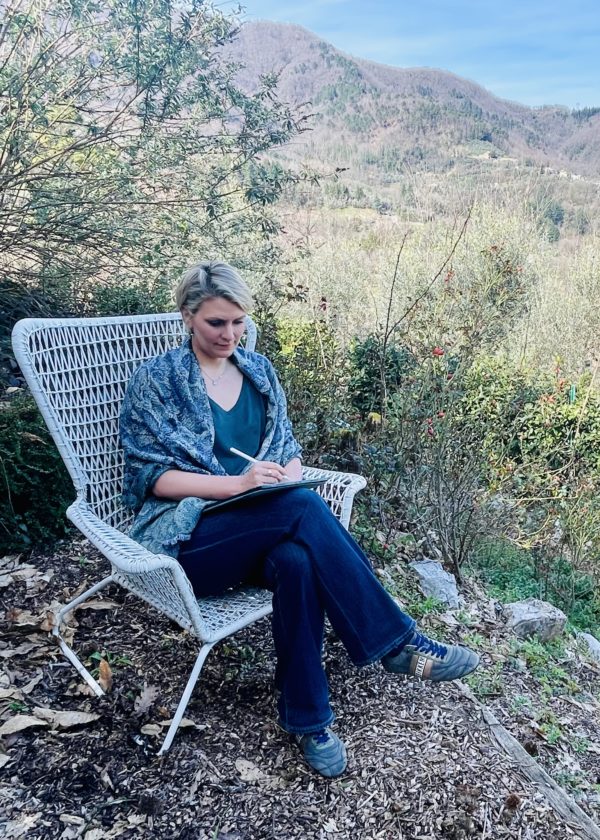
Independent thoughts
I love working with other people. It satisfies me to be of service and make great projects possible. I thrive in contact with others.
So I understand that many see consulting as a way to “do something with people.”
Part of the truth, however, is that consulting also means stepping back, being alone, and thinking your own (rather than rehashed) thoughts.
For me, an important counseling skill is to develop imagination and to engage in philosophical aspects. The art is not to get stuck in that but to question your own thoughts again and reconcile them with reality, numbers, data and facts. To inspire with new thoughts and then to shape them together into a new narrative, from which new worlds emerge with tools of the trade.
Active learning from and with the outside world is important to me. However, I want to process the “learned” and “refine” it with my own views.
A big part of the work of a consultant is not visible. The collaboration with the client is only the tip of the iceberg, so to speak. Much of my time is spent not in busyness, but in “active thinking”. My “quiet time” is the investment in the time savings and insight the client experiences in the collaboration.
The time I spend with the people in the client company is 100% quality time that creates real impact and adds value.
This gives me the feeling of doing a fulfilling job I love.

Personal portrait Irina Hagen
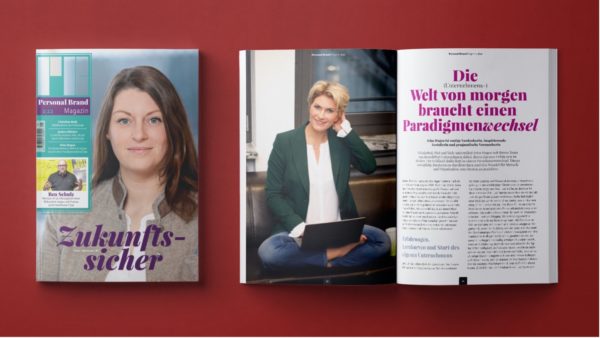
Would I have thought back then that I could successfully manage a consulting company for more than 10 years on the market through several crises? No, probably not.
Back then, I was rather naive about the whole thing and kissed the one or other wall, or rather the wall kissed me – without asking 😉 All the more, I am happy today to be described as a “courageous ahead thinker, inspiring creator and pragmatic demonstrator”.
Hard work and the joy of reflection, questioning, and learning got me there.
Learn more about what inspired me to start up in this blog post.

Myth of shortage of skilled workers (Part 2)
After I pointed out in the last article about the danger of the self-fulfilling prophecy regarding the shortage of skilled workers belief, today, we look at how talents are won in a highly competitive market – despite the lack of skilled workers.
The good news is that while supply is tight, the willingness to switch remains high. According to EY’s job study, 48 percent of employees show interest in changing employers. To learn how to keep your best people from looking elsewhere, read the next blog post.
First, let’s look at how you attract the suitable candidates.
Basically, there are many channels and a seemingly endless list of measures. I am not talking about employer branding, benefits or process elements but about increasing the attractiveness of individual positions and ways to create capacity. I’m more about a general view here, especially for hard-to-find, highly skilled roles.
It is essential that the recruiting team is thoroughly aware of each function and the situation of the colleagues and makes sure that all backgrounds and challenges in the daily work of the role are known. If recruiters are only superficially familiar with the content aspects, recruiting will not add value and recruiting measures will fall flat. Generalities, truisms, and empty phrases are counterproductive and tend to scare people away.
Game Changer

I’m a big advocate of well-founded role profiles and thoughtful job descriptions. The more intensively the manager and recruiter engage with the opportunity, the more concise the USP becomes, i.e. what makes the job exciting for a specific target group. The energy invested here pays for itself many times over in the course of events. You find the right people faster, spend less time in unqualified interviews, get on a more personal level with the candidates, and shorten decision cycles. Employees find it easier to recommend colleagues if they have something more to go on than just buzzwords.
Based on a sophisticated job description, a convincing job advertisement can then be developed depending on the channel, e.g. for employee referral programs, active sourcing, headhunter briefings, social media, and the classic job portals.
Even if there are only a few potential candidates on the relevant platforms, it is advisable to roll out the red carpet for the “might be interested” and searchers and to make the application process as convenient as possible. After all, opportunity makes applicants. I’ve often seen people who weren’t even planning to look for a new job, but who, through a spontaneous “take a look,” came across a job posting that stood out from the general blah-blah so much that they just wanted to give it a try.

7 recruiting hacks to make individual roles more attractive
Here are a few tricks on how to make positions so fascinating that potential dream candidates can’t resist and how to attract the right professionals.
Whether in a personal interview, on the career page, or in the job posting. Content is King; Context is Queen. And as most people know, the king needs the queen and vice versa; they belong together.
Context in this case means that each role is embedded in an overall construct. People like to be part of something meaningful and experience their self-efficacy. Not just something bigger, but something personally important to them. Some call it Purpose, but I don’t want to go that far. In a company, it is unlikely that everyone will be able to live out their life purpose. However, their own work should still generate visible added value.
Content means that both the description of the organization and the individual roles reflect meaningful content, not just the usual empty buzzwords.
I like to use the elements of Vogler’s Hero’s Journey when working out the story of the company along with the organization. Questions I ask myself are, for example, what adventure is ahead, what are challenges, who are companions and allies? Who (in business also often what) are the adversaries (e.g. lack of IT infrastructure), what are the mentors and role models? (We want to be like Spotify or we want to be like Amazon, but friendlier, ), what are the trials and crossroads? What weapons (methods and skills) are needed? What does the new world look like in the future?
Once these questions are answered for the overall company, this can be broken down to the individual roles. I am aware that creating job descriptions is a tedious and unpopular task. I don’t encounter a lot of love when I ask executives to revise them. Why invest time in something that’s already there? But by working on the meta-level with a practical connection to actual everyday life, different descriptions of what is factually needed often emerge. In the end, ultimately new aspects are brought to light that make the job unique and desirable – for the target group. Managers discover a new enthusiasm, as this work makes their leadership work much easier. The courageous develop a team task out of it, which has incredible team-building power. When creating role profiles for freshly minted colleagues, their own relevance in the team becomes clear. Team members learn that heroes and heroines look diverse and are all equally important. Each and everyone counts and winning can only be done together.
Questions that are answered are: Why is this one role so indispensable to the big picture? What would be missing if this position didn’t exist? I like to work with the Job Role Canvas.
Sometimes it takes looping through the works council, but they are usually pleasantly surprised and happy to agree to the changes. The job doesn’t change, but the context and in-depth content makes it more understandable and attractive.

There’s a pinch of loving biting in here again. Nevertheless, it shows why the pipeline is not filling up with suitable candidates.
The most crucial thing in a job posting is coherence. Sometimes everything is described in just a few points because the rest follows from that. Again, the Hero’s Journey and the Role Design Canvas help here. What exactly is it about, what is to be achieved and why. What added value is to be achieved? Why is which competence necessary? What can someone with a university degree do better than someone with only an apprenticeship? Why exactly is team spirit needed? How are communication skills used? The fact that a salesperson should be good at selling doesn’t need to be mentioned. But what exactly does selling look like in this role? When does selling start and where does it end? How is quality measured in sales?
Tasks are constantly changing and have no place in a job posting. What goals are set and how are these intentions related to the purposes of the team and the entire organization? What should be different after a year in the role or continue to be ensured under what conditions? How do you know you are successful in the job? What does a good result look like and what does a very good outcome look like? How do general conditions determine the scope?
The meta-level goals give meaning to the role. To be compelling, you need a concrete connection to everyday life. What is important is what is to be achieved. Instead of “create reports” instead “ensure transparency and decision basis through regular reporting”.


Regardless of the channel, team leaders and recruiters are well served if they have specific job advantages down pat.
From the outside, it is often impossible to tell what opportunities and potential the job offers and for whom the job is suitable. Does it hold a stepping stone to a new career level (more than other jobs), does the job lead to high visibility in the company, How much self-realization and creativity is possible? What outstanding personalities are worked with? Does the job allow me to integrate family, hobby and horse well into my working life?
The answers are often not conscious, but explicit mentioning will increase the attractiveness and the willingness to change significantly.
In the discussion about headcounts, team leaders are often put on the spot when part-time employees apply. A change in thinking is needed here.
Experienced professionals may prefer a relaxed routine, little overtime, without losing their importance. They bring immense added value to the company with their trained eye and confident manner.
The market is full of people who think along these lines and are willing to take on new challenges even at an advanced age. But under different conditions. Formulating this publicly opens up an unimagined market share.
In the next post, I’ll talk more about the internal opportunities of how to shape part-time jobs and generation-friendly structures.
Salary is a hygiene factor and remains among the essential criteria for a new job. Salaries have changed drastically in recent years, whether you feel it is fair and reasonable or not. It is what it is. It’s an old adage, if you pay too little, you get poor quality. In simpler terms, if you buy cheap, you buy twice. Then not only one person is needed, but others have to compensate for the lack of fit.
If a roll was last evaluated five years ago, it is certainly no longer up to date. Often, a new evaluation can change the tariff group to which the role belongs.
The team structure must also be re-evaluated in such cases. Fair employers also pay for an expanded role over the years, not just the usual 2% a year.
Those who lure whopping pay increases once you’re on board and acclimated usually pay a high price. Newcomers notice very quickly how the cat jumps and draw the appropriate consequences. Either they go straight to the competition or adjust their performance to the pay. If they stay with the company, cynicism and mistrust often spread, which has a negative impact on the entire team.

The number of candidates in the pipeline is still one of the most popular metrics in recruiting. Unfortunately, it often only shows inefficiency, but not quality. Ideally, you have an application and a dream match and a decision that takes only a few days from receipt of the documents to signing the contract. A full pipeline is usually more indicative of a run-of-the-mill job posting, with everything and nothing applying, and an inefficient process where candidates bob along for too long.
But better metrics and valuable insights include Days in Workflow (as few as possible), When do most drop out and why, How many new hires are promoted over the next two years. How is the Candidate Experience, i.e. the satisfaction of the candidates in the process (e.g. through an automated survey).

Myth of shortage of skilled workers (Part 1)
A lack of qualified people is a problem for almost all companies. Statistics from renowned institutions clearly show that there is too few skilled personnel available in Germany. The ratio of retirements to university graduates or even births can be frightening. Orders are not executed or not executed well because suitable personnel is missing, customers seek refuge with competitors who deliver quickly. Like the rabbit in front of the snake, many stand in front of empty candidate pipelines. Full of concern is the explanation: the shortage of skilled workers. The supply of qualified, motivated and affordable personnel is scarce. The pain is real.
That’s right, BUT…
In discussions with executives, management and recruiting departments, the shortage of skilled workers is almost fatalistically conjured up – even though there is no shortage as such. Overall, this may be true when comparing vacant positions with available qualifications. But at the individual company level, things look different. Today, there is a lot of room for maneuvering in every company, both on the supply side and the demand side. If you know how to use them, they are much easier to exploit than you might think. Neither are there is a need for so many vacancies nor are there too few applicants and candidates. Companies that have understood this benefit from decisive competitive advantages.
Before we talk about solutions, I would like to point out the danger of the attitude “Help, we have a shortage of skilled workers! The worrying statistics and studies are all correct, but not necessarily “true.” If we take the shortage of skilled workers as an undeniable truth, we create a reality in which we have little room for maneuver. The seemingly hopeless situation is cause to stop trying. Companies and recruiting departments are weary and frustrated – according to the motto, “it’s no use anyway, that’s just the way it is, you can see it everywhere!” You know this in sports: If you don’t believe in winning, you won’t win. You give up before you’ve even started. And so the downward spiral turns faster and faster in the wrong direction and the vicious circle begins.
Vicious circle scenario 1: Leaving jobs unfilled for too long

A low-spirited mood caused by excessive workloads does not exactly promote the willingness to perform – withdrawal or illness are the results.
In the end, people decide to quit. Regardless of whether it’s internal termination while remaining with the company or an external transfer – the need for new capacity is unnecessarily increased. The shortage of skilled workers starts a vicious circle again.
It is better to discuss with the team which tasks are to be taken over without losing quality and which are not. How to organize otherwise, what needs to be communicated to stakeholders and how to create a solution for all sides. A wonderful team development exercise that generates new ideas for increased efficiency, positive mood and commitment.
Vicious circle scenario 2: Hiring the next best
In the absence of suitable applications, someone is often hired despite severe doubts. But recruiters and team leaders have reached the recruiting goal for the time being. “You have to give people a chance; he or she will learn” is the silent but illusory hope. In that case, one can only hope that the mis-hiring is quickly and clearly recognized and the person leaves the position or even the company. It is worse if the person stays in the company even though it is known that it is not an ideal appointment. The message to everyone else is straightforward: “This is the new standard!” High performers then consider whether they have a future in the company, whether the commitment is still worthwhile or whether it is better to leave.
In principle, it is of course only right that many talents should be given a chance and that one can acquire a great deal. Hand on heart: Does the person have a real chance of becoming successful in the job? What does it take and can this actually be made possible (not just theoretically)? I am talking about e.g. longer time for onboarding, a lot of patience on the stakeholder side when things don’t work out right away, external training, a team member who takes over the more intensive onboarding and can be relieved for it in another place, etc. If the possibilities are limited, it is not an opportunity but the road to hell for the new team member.
Vicious circle scenario 3: Becoming a desperate pleaser
Those who have already understood that the candidate experience is the be-all and end-all often fall into the attitude of the devoted servant in the recruiting process, who does everything for the dream candidates. Better not to ask too demanding questions, better not to criticize. Better to take no position than the wrong one. Smile and say yes and amen to everything the candidate wants. I know I’m being a bit polemical here.
Nevertheless, it happens very often that interviewers mainly want to be loved by candidates. Pal-like exchanges are usually disguised as supposed eye level but are often pleasant but superficial talking around. In the best case, it remains in the candidate’s memory as comfortable and sympathetic but is much more often perceived as meaningless, not very professional and, above all, without any reliable insight. There is a big difference between chumming up and trying to please at all costs, and being aware of your own value and appearing humble in the sense of cooperative and appreciative. Other employers who allow themselves more depth and confidence in evaluating fit usually win.
Vicious circle scenario 4: Parking applicants in the second row
Who hasn’t experienced this: You have someone on the hook, you know it’s not really a good fit, but you don’t know what’s to come. Rejection then feels like giving away your safety net in an uncertain future. So you put off. And put off. And put off. The candidate notices this, of course. The enthusiasm for the company or the job decreases. If no one else can be found, you already have a new employee on day 1, who is cautious at first and not super committed. Maybe there are other offers in the pipeline, one takes the job for the time being, behaves similarly loyal and looks at what else is coming, and takes the first job that promises more commitment to the person in the recruiting process. At worst, there is a negative evaluation on employer portals. The chance that a better option will then apply is vanishingly small.

Vicious circle scenario 5: Set requirements as low as possible.

The result is a profile that is slimmed down beyond recognition and is more reminiscent of an unskilled assistant than the expert you are hoping for. In this context, I recommend that you refrain from using junior / senior expert roles in the title of the job advertisement. Because neither the junior nor the senior feels addressed by it. Rather publish a coherent entry-level position and an additional experienced position.
The expert desires to be seen in all the excellence, no matter the career level. Overcome challenges that others can’t. Being aspirational can be very sexy to the suitable candidates looking for that same job, but don’t apply when less qualified people fit. Who likes to throw their pearls before swine?
It needs a paradigm shift
Enough of the vicious circles. We can do better. Let’s usher in the paradigm shift. Let’s break through the mental blocks and use our creativity: Suppose there was no shortage of skilled workers. Assuming there is, what would you do to attract the very best placement for your team?
My ideas on the myth of the shortage of skilled workers can be found here in the next blog post.

Irina Hagen
As a courageous forward thinker, inspiring designer, and pragmatic pioneer, Irina Hagen and her team support companies in rethinking their own success. For her, the key lies in a paradigm shift. This makes it possible to break through barriers and shape change for the best for people and organizations. Irina inspires and fascinates with clarity, courage, and depth in her work and the resulting ideal added value and measurable results.
For the human business world of tomorrow
The good news is that those who integrate these changes into the company in a meaningful way and translate the rethinking into pragmatic and coherent action have the best chances of winning over people and markets.
A successful future in a rapidly changing world can only be achieved with a courageous paradigm shift.
Irina stands for this change. She opens doors and shows what is possible when potential is fully developed. Entrepreneurial, human, valuable.
She loves surfing on complexity and creating new corporate worlds together with people. The portrait describes what drives her, where her awareness comes from and why she places so much value on depth and simultaneous lightness.

The (corporate) world of tomorrow needs a paradigm shift
Irina Hagen is a courageous forward thinker, inspiring creator and pragmatic pioneer. With clarity, courage and profoundness, Irina Hagen and her team at MenschWert support companies in rethinking their own success. The key lies in a paradigm shift. This makes it possible to break through barriers and shape change for the best for people and organizations.
Irina’s career:
Irina Hagen’s professional career began after her high school graduation in the field of business administration. Through the intervention of a friend, a first great opportunity opened up, and her path initially led to Ireland. Maybe not precisely her dream destination, but here she got the opportunity to make a difference at a young age. She tells of her time in a large international company in Dublin: “We were 400 people on one floor. On the way from the front desk to my desk, I passed seven countries and heard countless languages.” She was immediately in the thick of things, helping to build a new European Service and Financial Center.
Back in Germany, Irina Hagen’s career remained international. As Executive Assistant at an international leasing and financial services company, she made a first-class start in the company. She worked long and hard and is grateful today for this intensive time. “I learned a lot about business and the bigger picture, had a 90-degree learning curve almost every day, and realized what was possible in terms of career,” she reports. Her journey then took her to an international human resources services company. She always wanted to work for and with people – with a lot of ambition, further training and determination, she worked her way into the recruiting team. However, as a woman in a male domain, she faced some headwinds here, especially since her male colleagues did not welcome her promotion from Executive Assistant to the Head of Central Europe to Division Manager. As long as Irina Hagen remained moderately successful, it would be fine, but she was and is not the type for mediocrity.
Setting up a business is a demanding task, which Irina Hagen took on and built up her company MenschWert step by step. Her exceptionally good entrepreneurial intuition allowed her to adapt to the respective situations and look to the future. Irina Hagen quickly received orders from well-known companies, including Amazon, Pro7 and Sky, and large projects that she led to success. “One of my big drivers is my curiosity and my will to better shape the future for and with people in organizations,” says Irina Hagen. In doing so, she acts as a thought leader who likes to inspire and make people think and as a trailblazer regarding the pragmatic implementation of modern concepts in which people work together, create economic and ideal value, and actively shape how people work together.
Irina Hagen believes it is crucial not only to scratch the surface, but to develop a deep understanding of organizations and the people within them. Because of this, she added psychotherapeutic training to her already strong business expertise. “Many principles from humanistic psychotherapy can be applied to organizations. I use that in my work,” says Irina Hagen. Here she also connected to corporate culture, because just as people have healthy or dysfunctional psyches, companies have a supportive or a hindering culture. The idea behind it: She also wants to use her work to offer a kind of “psychotherapy for companies.” This shows that Irina Hagen likes to think outside the box, boldly break new ground and inspire organizations. Her openness to new things also comes into play, for example, on trips through Asia or the USA, where she likes to visit companies or tech hubs. She has been a guest at Google in Singapore and on the campuses of Amazon, Apple, Ebay and Facebook.
In 2016, she was on stage at one of the first events, the Women Techmakers Forum, of the fledgling Google Office in Munich. She was one of the first speakers and inspired women in tech to generate more impact through design thinking principles with her talk. Especially by living their “female” attributes and enriching the tech world with additional perspectives that have not been appreciated so far, such as empathy, collaboration and multi-perspectivity.
“I want to open the door for people and show what is possible. Executive management, middle management, and their teams often experience the enormous, previously unnoticed potential of already existing resources when they are given the appropriate platform,” Irina Hagen tells us.
From her experience and her experiences, she knows that a change in thinking must take place and that a successful future in a rapidly changing world can only be achieved with a paradigm shift. Change management in the conventional sense often assumes a more or less linear, logical development. However, successful companies need rethinking in addition to continuous improvement. “Real change is not continuous improvement or optimization, but an all-encompassing and profound reorganization.” To support this statement, Irina Hagen draws on an analogy from the animal kingdom: a tadpole undergoes the transformation to a frog and does not become a new tadpole that can suddenly live on land. Organizations, too, already have everything in them to make this transformation. What is missing is sometimes the imagination, or the idea of what new worlds a frog can conquer, what new markets and opportunities are open to the “frog” instead of the tadpole. In this process, Irina Hagen is at the side of the organizations as a thought leader and pioneer. “Bold and profound renewal from within is necessary to give a world dominated by change and a volatile environment the clout it needs to thrive. Ultimately, it’s about breaking existing thought patterns. If you want a new outcome, you have to do different things. Long-entrenched best practices that were successful in the past no longer work today.” To usher in the paradigm shift, she and her team at MenschWert work at different levels: with the organization, management and individual employees. “In my work, I impart knowledge about interrelationships and, in reflection, generate insights that go far beyond the professional. And that’s what makes the work so enjoyable. I see business success while also being able to contribute to the personal development and satisfaction of individuals.”
For Irina Hagen, every project also means further advancement, learning new things, and improving things. In doing so, she likes to take on the operational role for a while, e.g. as an interim manager, to really know afterward in consulting which problems exist in everyday life and how they can be solved. Again and again she proves – also in a scalable way – that humanity and business are not mutually exclusive, but need each other to ensure the company’s success in the future. Together with her team, she would like to implement many more projects with and for her clients and make the (working) world a better place. “I see myself as a bridge builder, thought leader and designer who creates the connection and holism to achieve great things together. If the experience is made that together in the organization great things are possible, this will have an impact on people’s personal environment and thus a positive contribution to our society will be noticeable.”
Irina Hagen wants to shape change and the associated paradigm shifts actively. She sees herself as a creator of meaning and a forward thinker who likes to inspire and make people think.
She is a trailblazer regarding the pragmatic implementation of modern concepts in which people work together, create economic and spiritual value and actively shape togetherness. Her curiosity and commitment to excellence motivate her to evolve, learn new methods and expertly anticipate trends constantly.
Together with her team from MenschWert, she accompanies and supports companies in the paradigm shift and the associated profound transformation.
Irina Hagen founded the consulting company MenschWert Consulting GmbH in 2013. Learn more about her self-image, her role as a consultant and interim manager as well as her background and expertise here.
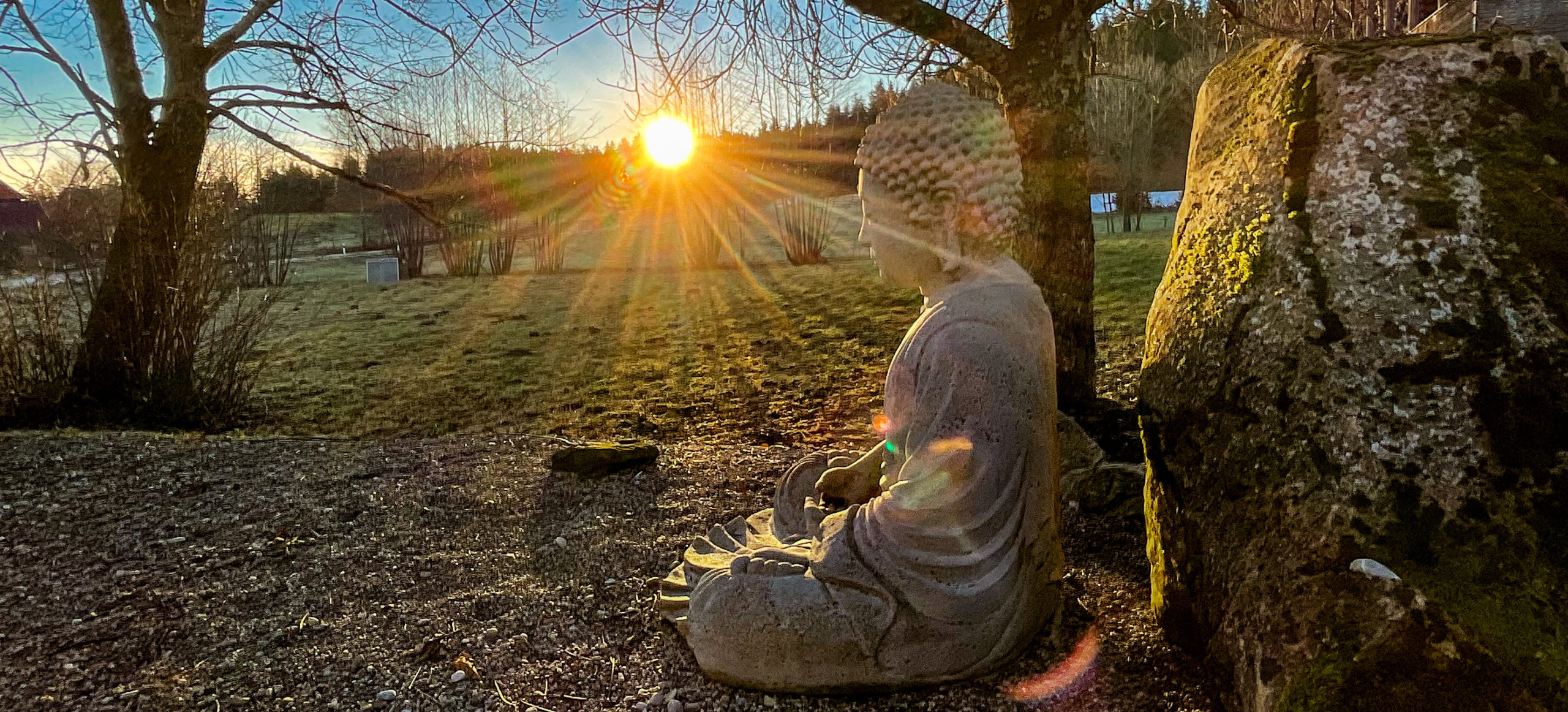
Silence in a Zen monastery instead of the New Year's Eve party
Energy! Strength! Silence!
A week of meditation and silence in the Zen monastery Buchenberg to spend the turn of the year in vibrant silence.
I am convinced that whoever works with other people, provides guidance and wants to explore new paths and shape those ways together with others, needs a foundation in him*herself and in his or her own being. One of my sources of stability for a strong foundation that also holds in the storm is Zen. That’s why I’m using the time off from parties due to the pandemic to recharge my batteries in a one-week Zen retreat. This is not a wellness vacation, even though it does me good and I feel renewed, full of energy and completely recovered mentally, spiritually, and physically.
For the vain among us a little bonus tip: After a week, there are compliments to the noticeably recovered, possibly rejuvenated appearance, and a great radiance included.
Still, reactions range from “You’re nuts!” to “I could never do that!” or, more to the point, “Holy shit!”.
Since 2010 I am a convinced “Zenni” (sometimes more than others) and try to live the principles of Zen philosophy. More about this later. First of all, Zen as such is not necessarily religious. I am not a Buddhist. The Buddha is not a deity in Zen, but the symbol of one’s own pure, clear mind.
It’s primarily about being present in the moment. Zen meditation focuses on living in the here and now, freed from all thoughts, feelings, morals, concepts, and patterns of behavior. The practice focuses on the situation as it is, without judging it, and thus one reaches (with a lot of training) a state of mental calm, emptiness, and silence. This state is described as a release from oneself or even a positive feeling of emptiness. Suzuki even speaks of the “great freedom”. However, Zen is not only meditation, but determines a whole attitude towards life and being.
Hinnerk Polenski founded the Daishin Zen tradition, which has its (physical) home in the monastery of Buchenberg. Daishin means as much as heart spirit, which casually expressed, stands for the connection of heart and brain.
So, what exactly does that mean for me now?!
Anyone who knows me knows that getting up early is not really my thing.
Then why get up voluntarily at the crack of dawn and be silent in a large room lit only by dim lights and candles with other strangers?!
Because meditating is not doing nothing. It is focus and concentration, sometimes really tough. Especially with lack of sleep certainly not fun. And sometimes it’s exactly these situations that bring me to my limits and thus closer to myself and thus to others. And hand on heart, it’s also a good exercise, because in everyday life it sometimes happens that you want to give full performance and concentration with little sleep. A bit of training for these situations, which should remain exceptions, does not hurt.
Those who know me know that for the free spirit in me, rules and time statements often mean only a rough guidance.
Why then do I quite voluntarily subordinate myself to a meticulous timing and precise processes, where I am obediently on the spot on time, bow, stand up, sit down, walk across the room at a 90 degree angle, eat and drink, talk and keep silent when I am told (only the first time, the second time it ideally works without having to be told).
Admittedly, sometimes I actually wondered what I was doing there… After all, I could still be comfortably snuggled up in bed or sitting together with friends in the evening with red wine.
And then this childlike joy comes back, reminding me how good it sometimes does me to have this external order and structure, so that I myself don’t have to constantly think about and decide what and how to do, but can let myself fall into the clear order of monastic life.

It always surprises me myself how beneficial this structure can be. This structure leads not only to efficiency, but more importantly to unity. When everyone is doing the same thing at the same time, the harmony of the whole is sometimes poignant to me. It reminds me how important a certain structure, rules, and established rituals are also in companies and in the working world. In everyday life, one probably speaks of reliability.
The feeling of unity and belonging is the basis for being creative and growing individually on the other side. In order to be able to achieve great things together, it is also necessary to sense exactly when it is important to subordinate oneself to this community for the benefit of all and when there is time and space for individual power and self-development. This also is an important experience that is allowed to be renewed again and again when it comes to building and transforming companies. Unity and individuality in balance.
Anyone who knows me knows that I love to talk and usually have an anecdote at hand. So how can I just stay silent for a whole week?
I think that is exactly why. It is precisely because I allow myself the silent time in everyday life and or clenched as in a retreat or sesshin that my thoughts can order themselves and become a plausible context. Meditation is about experiencing an inner emptiness, renouncing all the thoughts, and mental concepts for the moment to experience reality as pure being. This emptiness creates space for the new, for the essence (whatever it means for oneself and the world).
Heart spirit (Daishin) also means to feel compassion–with oneself and with others. It means to feel with, to feel together (in contrast to pity). The heart offers a few more impulses, which cannot necessarily be grasped with our mind, but which are real. It unlocks abundance–an expanded space with unlimited possibilities.

Why also be silent between meditations–for a week?
I choose this silence quite consciously. In silence and contemplation I hear my own inner voice. Whereby it is not directly a voice, but rather an “comprehension”. Sometimes it is quite irritating what I hear and understand there, because not everything that my inner voice gives me to understand, suits me at the moment. To get through to “reality”, to “look deeper” can be beautiful, but it can also hurt. They are not always eureka moments; sometimes insight can also be very sobering.
Occasionally, though, that inner voice has a sly tip, that one small but important impulse. In any case, I see more clearly and clarity gives orientation. Orientation shows me the options and scope that I and others have; this is also called the power to act.
It’s about feeling your own strength. To be authentic, to remain true to one’s own essence, in all the experiments that life has in store for us. Not a power in the sense of dominance from and to the outside, but the strength and balance from one’s own central core. This is easier said than done, and anyone who has ever consciously experienced being outside their own center knows, how strong the centrifugal force of the spinning wheel of life is and how difficult it is to return to the center. So for me it is pure common sense not to strain the center excessively, even if it is sometimes very tempting to surrender to the waves outside.
If you really want to listen, you have to be able to remain silent. And not just “not talk,” but also calm one’s own thoughts so that what is heard finds room in the mind and heart to have an impact. Because only then is deeper understanding possible and only then can the right decisions be made. Only then can leadership succeed.
To stay with oneself for once, to bear it alone with oneself, can be healing and strengthens not only one’s own middle, but also the relationships and connections to others. Those who are at peace within themselves and can sometimes take a step back can give space to others. In this space, new possibilities can emerge.
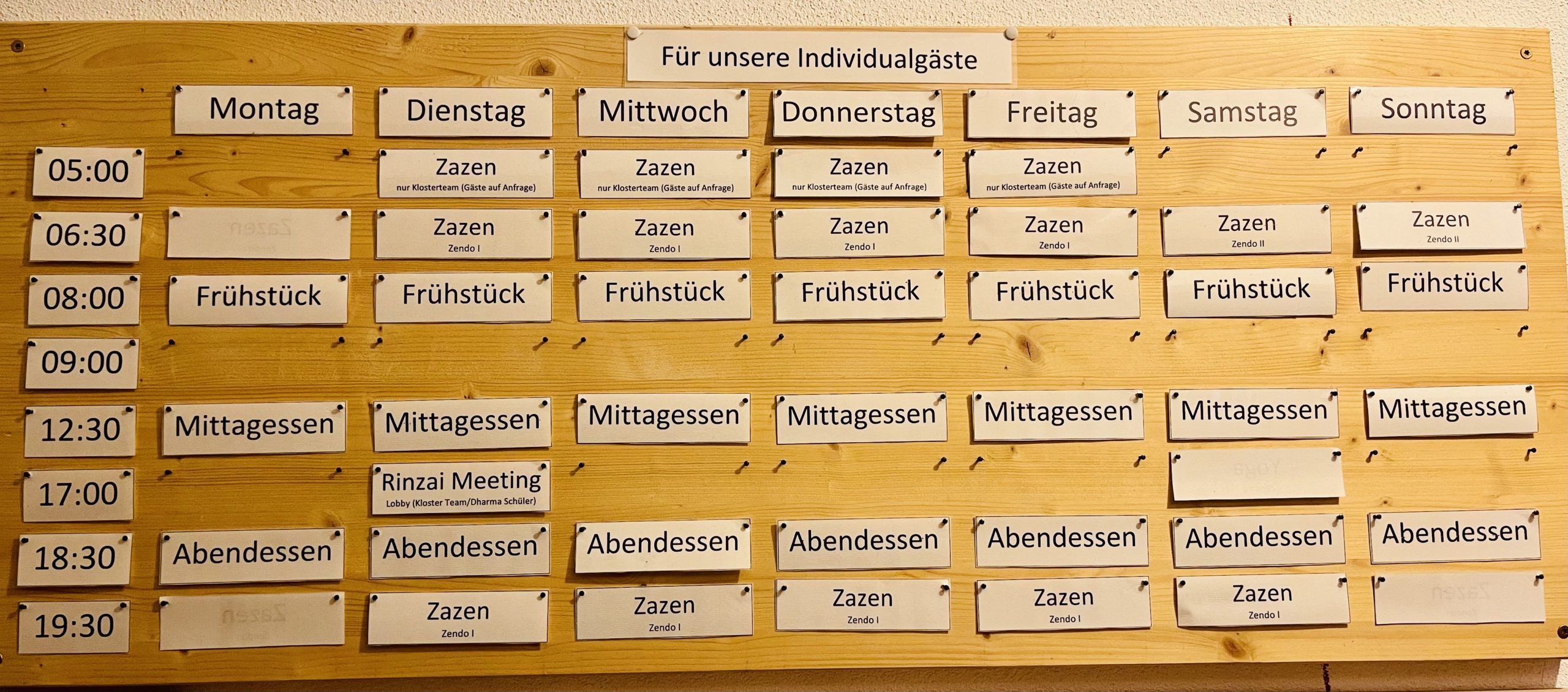
Those who know me, know that I like to work, gladly and a lot. (Which is partly because I love my work and partly because work also gives me a lot of energy).
I’m often asked “how do you manage all that workload?”, “Where do you get this energy from?”, “Where do you find this clarity?”, “How do you stay so confident and not lose your sense of humor?”, “How do you keep your cool?”, or “How could you have known?”
Often the Zen practice is the answer. Zen empowers intuition, sharpens powers of observation, and as a result I can synthesize information more meaningfully. Above all, it is training for intuition. Daishin-Zen stands for “heart spirit”, the connection between mind and heart, and the body also plays an important role. Daishin-Zen movements are not cautious or timid, but powerful, focused and swift, without being hectic. Often I have to make an effort to keep up (for example, in kinhin, the walking meditation, jaggedly in time and lockstep up a hill on uneven forest paths. There I have to concentrate so much, there is hardly any room for other thoughts–or while working in the kitchen). I admire the grace and pace with which the monks and nuns do their work or simply walk across the grounds.
Sitting for long periods of time in meditation–at sesshins this can be 10 hours or more per day–is at some point more than demanding. My spine is definitely not used to it. But it reminds me how important an upright stance is. And yes – even in real life, being upright can be tedious at times. But it’s worth not giving in to resistance, to temptation, because good energy can only flow when an uprightness is the central focus of one’s posture.
Observing the chores here, one gets a sense of what it looks like when “it’s flowing.” Precise movements, hand in hand, creative, harmonious and creating results with joy – without a lot of hoopla, without endless meetings, without babbling, without waste, without noise.
Even monastery guests are allowed to cooperate, at least in the day-to-day work. Well, actually the contribution, called samu, is not optional, because it is part of the Zen practice. Some people sometimes wish they had watched the cleaner at home better. But don’t worry, every job is patiently explained until every move is perfect, even for those who haven’t done any housework themselves for a long time. Everyone comes down to earth. It is fascinating how satisfying it can be to do the dishes or even clean the monastic toilets.
It is an invitation to do normally annoying chores like dishwashing, vacuuming, trimming flowers in silence and with mindfulness, yet in a certain time and quality. To be part of a team and yet be with oneself. Unbelievable how well collaboration is organized, with total strangers with a minimum of gestures or spoken words. The harmony in the processes is like a choreography.
How quickly, effortlessly and almost flawlessly the work comes off when you are fully present. So it’s also about performance, definitely top performance for me. Just without stress. Like Swiss clockwork, only a bit more creative and humorous–in other words, more human.
The transformation of companies needs this triad, especially when “high performance” is the goal; usually we then call it reflection, implementation (operational excellence), celebrating successes. Alternatively also vision & goals, products & services and corporate culture. Many managers want dedication from their employees and may find the key here. For any leader, anyone and everyone who wants to give leadership and power, Hinnerk’s Zen Leadership seminars are especially worthwhile.

The silence serves me well.
Not to run away and escape from the noisy world full of flaws and injustices, but to refresh my connection with the world, to sharpen my eyes and my sense for the good. To recognize my latitude, where I can have an impact on a better world–and where I can trust that the world will organize itself without me, which can be incredibly relieving.
The awareness that everything is connected to everything else. With this awareness that I am not alone, but that there are always people who want to be involved and shape things. The knowing that there is a force that can and wants to move great things.
There is the story of the Buddha statues made of pure, brightly shining gold. To protect it from destruction, weathering and robbers, over the years and centuries more and more clay was poured over it, so that the gold was unrecognizable hidden under a shapeless layer of earth. Buddhist psychology uses this image to also explain human shortcomings while “right as it is”. The healing teachings focus on making this golden core accessible and perceptible again.
My own clarity helps me to recognize the golden in companies and people, so that my clients can turn the proverbial sand in the gears into pearls. Supporting the emergence of new corporate worlds requires courage, mindfulness and strength. A business transformation is always a bit of a journey to oneself, as people also recognize new perspectives and develop new skills in a transforming context. There are so many unique and valuable aspects in the people I work with. Unlocking these treasures together and making them usable is most rewarding to me.
It is the time to cultivate friendship with myself, to be at peace with myself, despite all the things that upset me or that I do not accomplish.
The inner retreat is a time just for me. No one wants anything from me, I don’t have to be available for anyone. It is a time to cultivate friendship with myself, to come to terms with myself, despite all the things that annoy me or that I do not succeed in doing.
For me, it’s also a cure for loneliness. The feeling of connectedness (even and especially in times of social distancing), when my heart opens up and I really notice the people around me and their relatedness, even when physical closeness is not possible. The inner tingle when that connection “clicks” into place, like a magnet finding its place instead of just wandering around loosely. That feeling that it’s just as right as it is at this moment.

Zen is tangible and down-to-earth. In the here and now. In presence and in real life. Tangible connectedness.

This is not about esoteric enlightenment in some other better world, but about anchoring consciousness and strength in everyday life.
While many other meditation concepts focus on energy from above and inspiration, Zen draws strength from grounding. Those with their feet firmly on the ground do not fall over easily. Those who are deeply rooted can also flexibly adapt to the wind without losing their own position.
From the energy of grounding and the awareness of being rooted and upheld comes the space for inspiration. Inspiration that does not only live from idealistic dreams, but can be implemented tangibly in real life. How many plans fail because they have lost touch with reality? Zen is the (un-)gentle way to get ground under your feet again and to create real and thus sustainable results step by step.
In Daishin Zen, one is either in immersion or in the dynamic. Immersion can mean zazen (deep silence in sitting meditation) or the complete presence in the work; some know this feeling as “flow”. Both have it in them. It’s like a boot camp for body, mind and soul.
The body work, early morning exercise so to speak, before breakfast gets the fitness heart pumping. Mine definitely, it costs me the utmost not to just give up in the middle of it. Sore muscles are inevitable (I know my fitness could be much better). When I see the relaxed smiles on the faces of the others, even during the toughest exercises, I make a firm resolution to do more endurance and power exercises again.
By the way, anyone can join in from their own living room. What looks so easy is pretty damn exhausting–at least for me. Or vice versa, even if it’s hard, it still looks effortless. If you want to experience it in everyday life, in the virtual monastery, you can join in every day from 6 a.m. and on three evenings during the week, then often with lectures or guided meditation (Virtual Monastery Daishin Zen).
Especially at the beginning of the pandemic in March 2020, it did me good to have this community, to just sit together without discussion and opinions and create the path to alignment through awareness. In this way, I was able to be a source of strength for others even in times of uncertainty.
The good news is–after a week at the Zenkloster Buchenberg and with the anchoring in everyday life through the possibility to strengthen my practice daily in the virtual monastery , I know that I am so ready to be a good mentor to my clients on their journey into a new corporate world–with depth, strength, and humor.
Magic Moments


The turn of the year–unforgettable!





Ressource-oriented Exit-Management
Trennungen, aus welchem Grund auch immer, haben einen Einfluss auf die Team Performance, da sich zwangsläufig die Teamdynamiken ändern. Ist diese Trennung nicht gut gemanagt, also geht jemand einfach, wird eine Lücke hinterlassen. Eine Trennung beinhaltet immer auch einen Trauerprozess, in dem die Vergangenheit hinter sich gelassen wird und die neue (Team-)Konstellation sich finden muss. Gutes Exit Management besteht aus mindestens drei Perspektiven, das Unternehmen (meist in Form von HR), der / die Mitarbeitende, und die zurückbleibende Organisation bzw. das Team. Lasst uns gemeinsam erkunden, wie aus der Trauer das befreiende Gefühl der möglichen Neuausrichtung wird, damit alle Beteiligten bessere Lösungen finden, der Zusammenhalt und die Teamidentität vertieft und die Produktivität wächst.
XING Puls HR München

Wertschätzende Trennungen
Es gibt Situationen, in denen die Option „Alternativen finden“ für alle Beteiligten der sinnvollste Schritt ist.
Trennung bedeutet einen wesentlichen Einschnitt in das Teamgefüge und eine gewaltige Änderung für den Einzelnen. Eine professionelle Begleitung des Prozesses ist daher Pflicht. Hier wird erarbeitet, wie sich das Team zukünftig aufstellen möchte, es ist also die Chance für eine Standortbestimmung und Neuorientierung, aus der notwendige Lernerlebnisse geschaffen werden. Das Team kann hier erkennen, wie es zukünftig zusammenarbeiten will, was es braucht und wie sich jeder Einzelne auf die neue Situation einstellen sollte. Für den Mitarbeitenden wird ein alternativer Karriereweg gestaltet, der noch besser passt.
Wichtig ist, dass jeder aufgefangen und ermutigt wird, den eigenen Weg zu gehen. Damit ist die Zukunft vielversprechend und praktikabel. Die Trennung wird für alle ein gesichtswahrender Prozess, der Erneuerung, Eigenverantwortung und Teamerlebnis fördert.
Gerne bieten wir ein kostenloses und unverbindliches Sparring mit unserer Expertin Irina Hagen an.
Wie kannst Du die Dich ressourcenorientiert on einem Teammitglied trennen, um die ganze Organisation zu stärken und den Paradigmenwechsel im Team boosten?
- 30 vertrauensvolle Minuten
- Perspektiven ermöglichen neue Lösungsansätze
- Wegfindung, erste Schritte zur direkten Umsetzung
- Aha-Momente für ungeahntes Potential
Hier kannst Du direkt einen Sparring-Termin online vereinbaren.
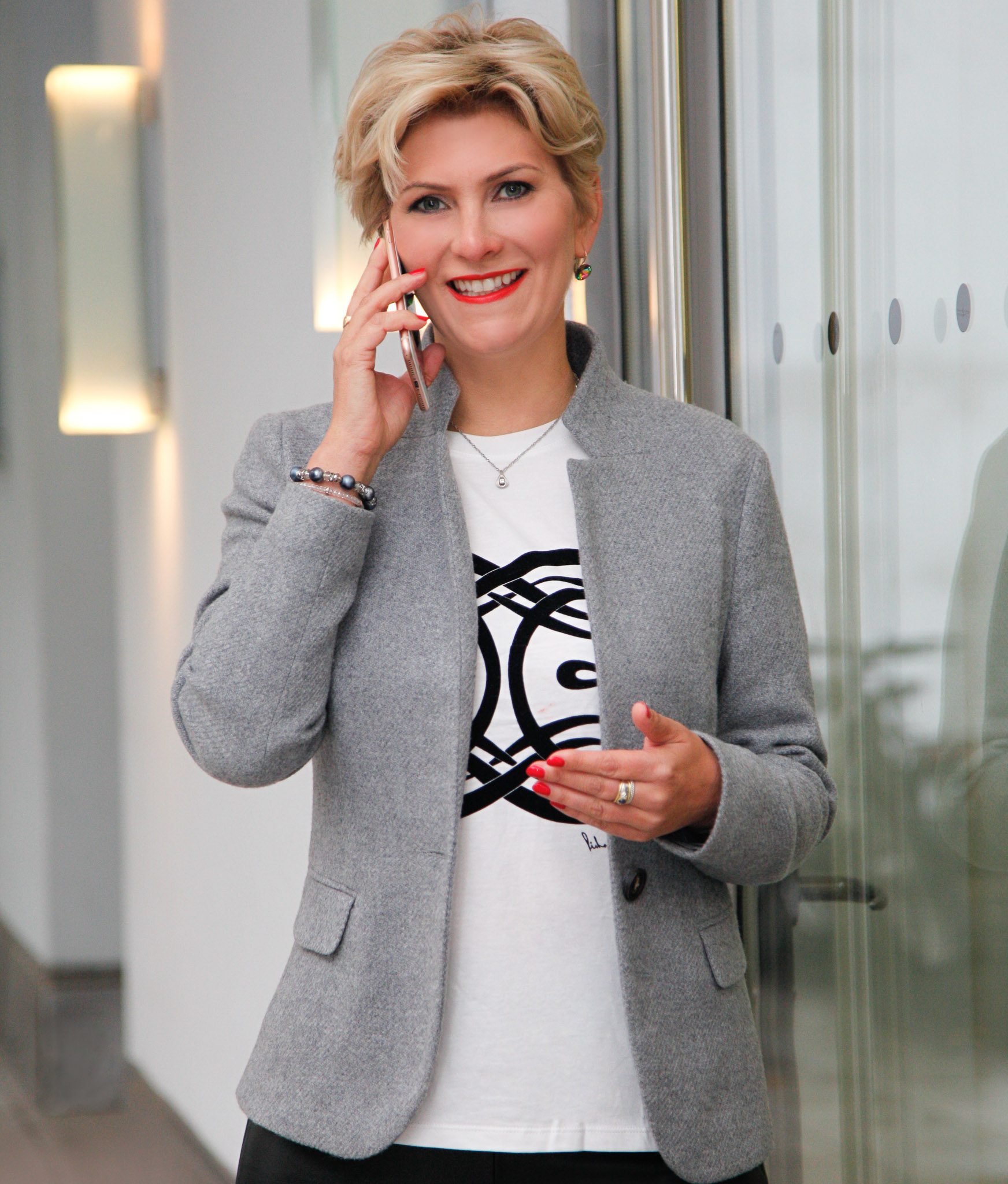
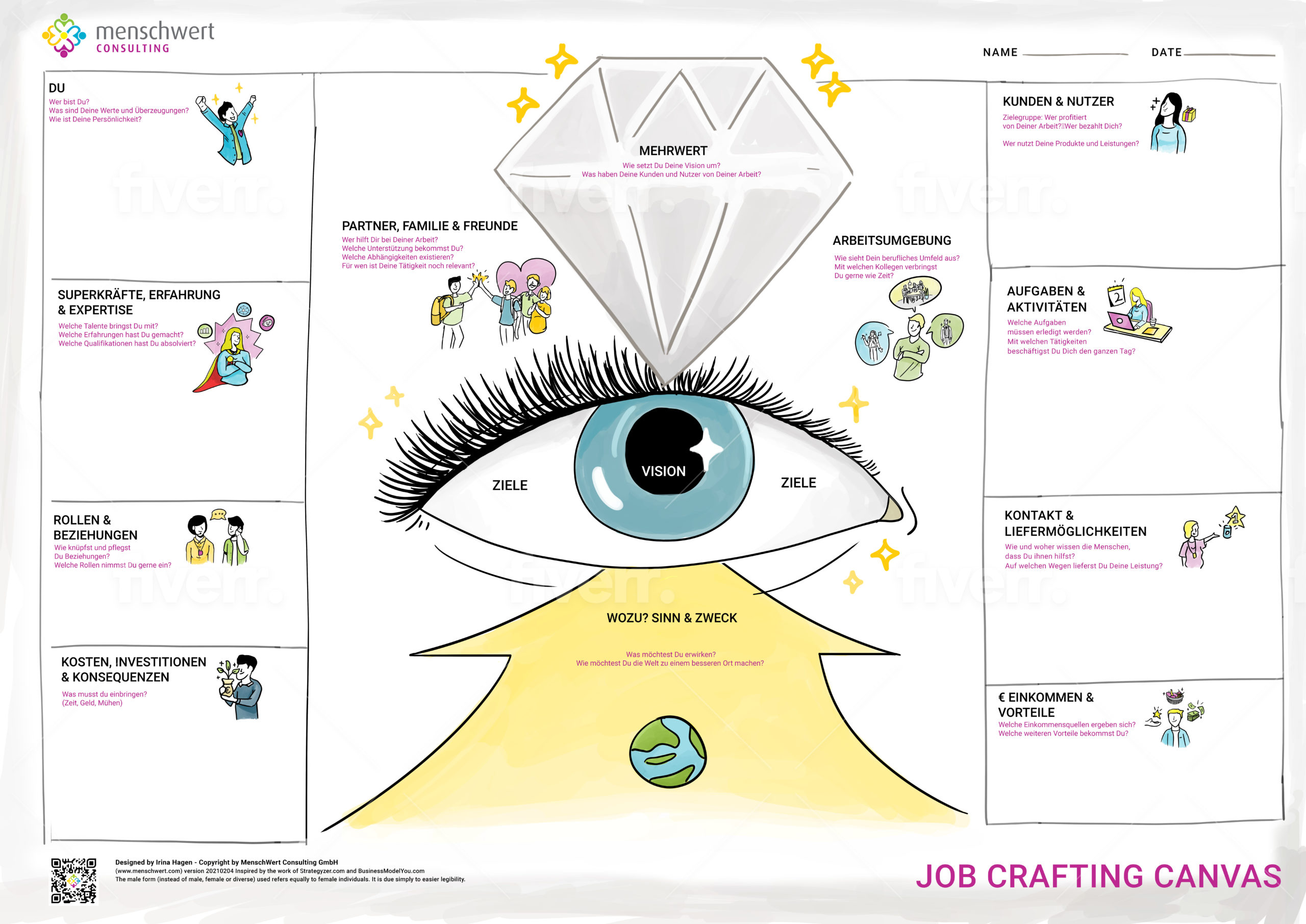
Muss es denn der Exit sein?
Die Job Crafting Canvas beschreibt eine innovative und wirkungsvolle Methodik in vier Schritten, um „persönliche Geschäftsmodelle“ zu entwickeln und den inneren Antreibern auszurichten. Mitarbeitende lernen, sich an Kundenbedürfnissen zu orientieren. Dies steigert sowohl die Motivation für die eigene Entwicklung als auch das unternehmerische Denken. Statt sich auf kleinteilige Aufgaben und Prozessschritte zu fokussieren, wird gefragt, welchen Mehrwert die Tätigkeit des Einzelnen für das Unternehmen bedeutet. Daraus entstehen neue Karrierewege, die Fähigkeiten, Bedürfnisse und Persönlichkeit des Mitarbeitenden einbeziehen, um sich so optimal an eine sich konstant wandelnde Welt anzupassen oder neue und befriedigendere Alternativen im persönlichen Arbeitsumfeld zu finden.
Die Arbeitswelt von morgen schon jetzt vorbereiten
Wir wollen die Meta-Ebene und die Welt der Buzzwords verlassen und konkrete Lösungen erarbeiten. In einem kurzen Impuls von einem Experten im jeweiligen Thema geben wir den Rahmen und stellen relevante Perspektiven vor. Der Rest kommt von euch. Wir achten auf eine 100% Beteiligung aller Teilnehmer, so dass verschiedene Perspektiven und Erfahrungsschätze einfliessen.
Dabei geht es darum verschiedene Methoden vorzustellen und auszuprobieren und konkrete Lösungen, die ihr direkt bei euch im Unternehmen umsetzen könnt, zu erarbeiten.
Wir freuen uns, wenn ihr selbst einen Anwendungsfall habt, oder eine Methode ausprobieren wollt. Kurze Nachricht genügt.
Wir arbeiten in kleinen Gruppen und Teams. Daher ist die Teilnehmerzahl begrenzt. Wir arbeiten an einem Thema auf verschiedenen Workstreams und orientieren uns an den Ansätzen Lean und DesignThinking.

Alternative to the Christmas Party - Celebrating Team Successes Responsibly
A plea for personal connectionsCorona forces us to be careful, to reduce social contacts to a minimum and all event possibilities, such as visiting the Christmas market together, celebrating in a bar or visiting the Escape Room have become almost impossible.
We humans are social beings, purely virtual contacts go against our nature. For the moment, we don’t know when the situation will improve. Even more so, we need tangible team cohesion right now, so that we can continue to do remote work socially and so that we don’t lose ourselves as teams.
In our webinar, we will show, how important closeness and connectedness are, why celebration is necessary, and how “LEGO® SERIOUS PLAY® as a winter party” can be used to meet the social needs of the team directly and sustainably in a responsible way. This happens either in the same physical space or alternatively we show you how emotional belonging can also be created virtually.
Based on a practical example, you will experience step by step how our Lego Serious Play Christmas party “works”.
On our Download-Page under Inspiration you can download the entire webinar in German.
Cohesion defines the team
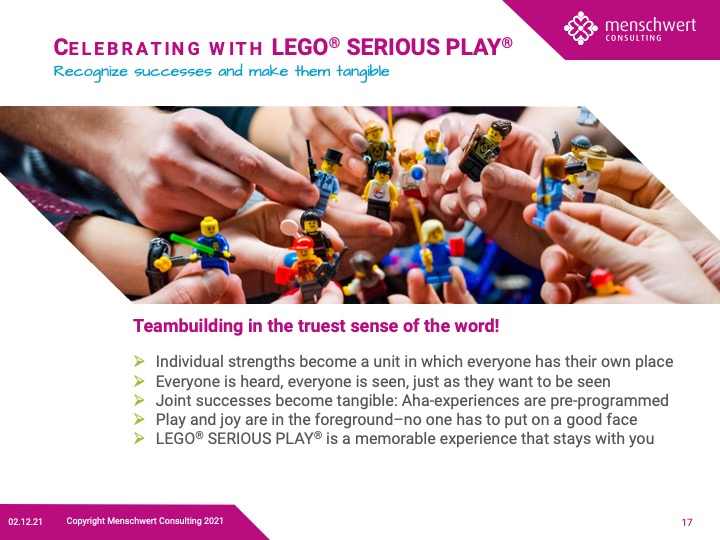
Lego Serious Play Winter Party
- Current situation & consequences
- Importance of team and cohesion
- Why are personal presence and closeness so important?
- Importance of a (Christmas) celebration
- Celebrating with LEGO® SERIOUS PLAY®
- Team building: Creating the fundament for the next year
Bedeutung einer (Weihnachts-)feier
Trailer WebinarEin kleiner Vorgeschmack, was Ihnen das Webinar zeigt. Viel Spaß damit.
For leaders, team enablers and party animals
who and Why?Celebration is elementary for the society.
Are you looking for a pandemic way for your team to celebrate the successes of the past year and to give the team a good foundation for a spirited start to the new year?
Give your team energy for the new year. Just give us a call, a lot of things can be clarified in a short conversation and additionally there are ideas what you can make possible!
Christmas surprises
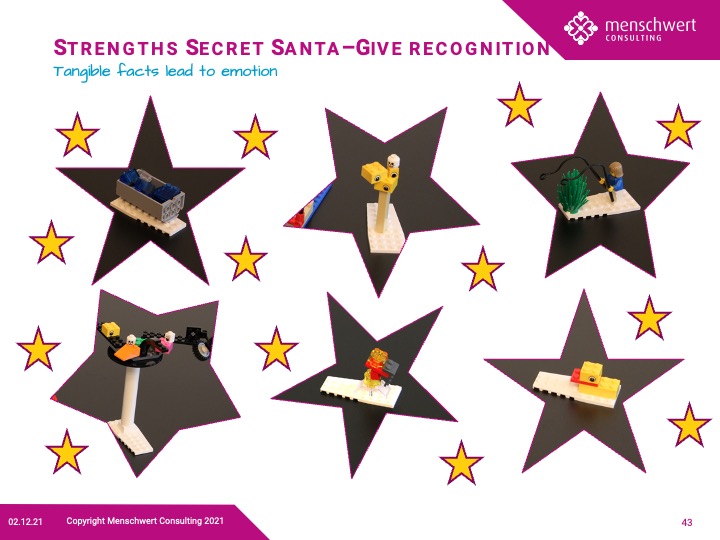
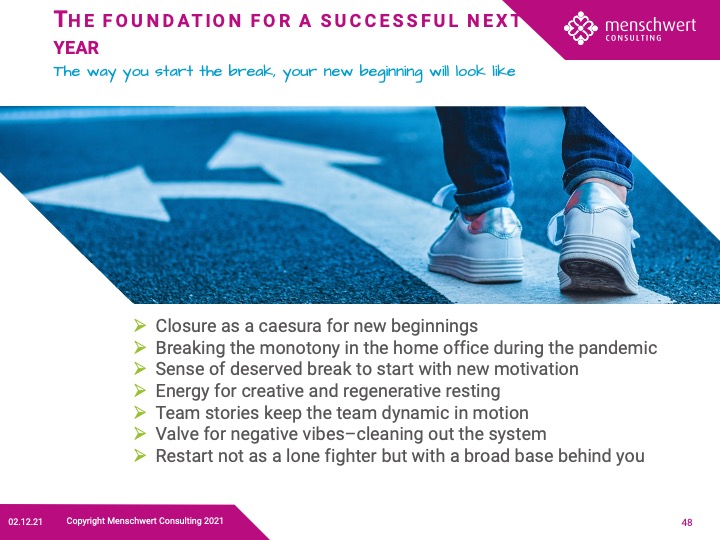
Young Professionals gewinnen, halten, weiterentwickeln: Zukunftsfähige Mitarbeiterbindung von Nachwuchskräften
Co-Autorin Irina Hagen